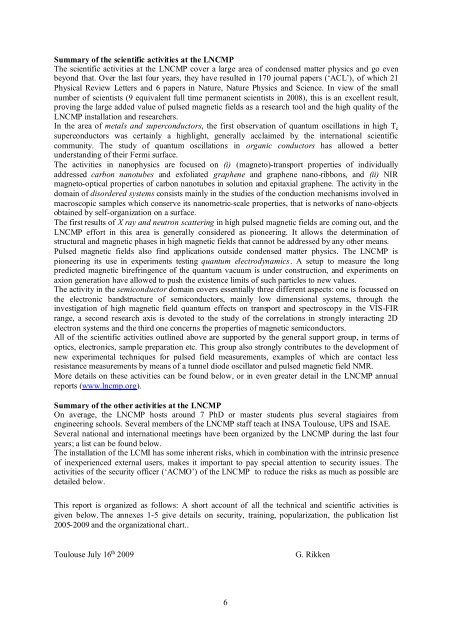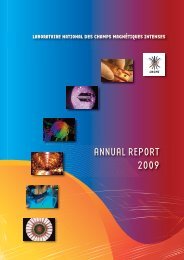Laboratoire National des Champs Magnétiques Pulsés CNRS – INSA
Laboratoire National des Champs Magnétiques Pulsés CNRS – INSA
Laboratoire National des Champs Magnétiques Pulsés CNRS – INSA
Create successful ePaper yourself
Turn your PDF publications into a flip-book with our unique Google optimized e-Paper software.
Summary of the scientific activities at the LNCMP<br />
The scientific activities at the LNCMP cover a large area of condensed matter physics and go even<br />
beyond that. Over the last four years, they have resulted in 170 journal papers (‘ACL’), of which 21<br />
Physical Review Letters and 6 papers in Nature, Nature Physics and Science. In view of the small<br />
number of scientists (9 equivalent full time permanent scientists in 2008), this is an excellent result,<br />
proving the large added value of pulsed magnetic fields as a research tool and the high quality of the<br />
LNCMP installation and researchers.<br />
In the area of metals and superconductors, the first observation of quantum oscillations in high T c<br />
superconductors was certainly a highlight, generally acclaimed by the international scientific<br />
community. The study of quantum oscillations in organic conductors has allowed a better<br />
understanding of their Fermi surface.<br />
The activities in nanophysics are focused on (i) (magneto)-transport properties of individually<br />
addressed carbon nanotubes and exfoliated graphene and graphene nano-ribbons, and (ii) NIR<br />
magneto-optical properties of carbon nanotubes in solution and epitaxial graphene. The activity in the<br />
domain of disordered systems consists mainly in the studies of the conduction mechanisms involved in<br />
macroscopic samples which conserve its nanometric-scale properties, that is networks of nano-objects<br />
obtained by self-organization on a surface.<br />
The first results of X ray and neutron scattering in high pulsed magnetic fields are coming out, and the<br />
LNCMP effort in this area is generally considered as pioneering. It allows the determination of<br />
structural and magnetic phases in high magnetic fields that cannot be addressed by any other means.<br />
Pulsed magnetic fields also find applications outside condensed matter physics. The LNCMP is<br />
pioneering its use in experiments testing quantum electrodynamics. A setup to measure the long<br />
predicted magnetic birefringence of the quantum vacuum is under construction, and experiments on<br />
axion generation have allowed to push the existence limits of such particles to new values.<br />
The activity in the semiconductor domain covers essentially three different aspects: one is focussed on<br />
the electronic bandstructure of semiconductors, mainly low dimensional systems, through the<br />
investigation of high magnetic field quantum effects on transport and spectroscopy in the VIS-FIR<br />
range, a second research axis is devoted to the study of the correlations in strongly interacting 2D<br />
electron systems and the third one concerns the properties of magnetic semiconductors.<br />
All of the scientific activities outlined above are supported by the general support group, in terms of<br />
optics, electronics, sample preparation etc. This group also strongly contributes to the development of<br />
new experimental techniques for pulsed field measurements, examples of which are contact less<br />
resistance measurements by means of a tunnel diode oscillator and pulsed magnetic field NMR.<br />
More details on these activities can be found below, or in even greater detail in the LNCMP annual<br />
reports (www.lncmp.org).<br />
Summary of the other activities at the LNCMP<br />
On average, the LNCMP hosts around 7 PhD or master students plus several stagiaires from<br />
engineering schools. Several members of the LNCMP staff teach at <strong>INSA</strong> Toulouse, UPS and ISAE.<br />
Several national and international meetings have been organized by the LNCMP during the last four<br />
years; a list can be found below.<br />
The installation of the LCMI has some inherent risks, which in combination with the intrinsic presence<br />
of inexperienced external users, makes it important to pay special attention to security issues. The<br />
activities of the security officer (‘ACMO’) of the LNCMP to reduce the risks as much as possible are<br />
detailed below.<br />
This report is organized as follows: A short account of all the technical and scientific activities is<br />
given below. The annexes 1-5 give details on security, training, popularization, the publication list<br />
2005-2009 and the organizational chart..<br />
Toulouse July 16 th 2009 G. Rikken<br />
6







